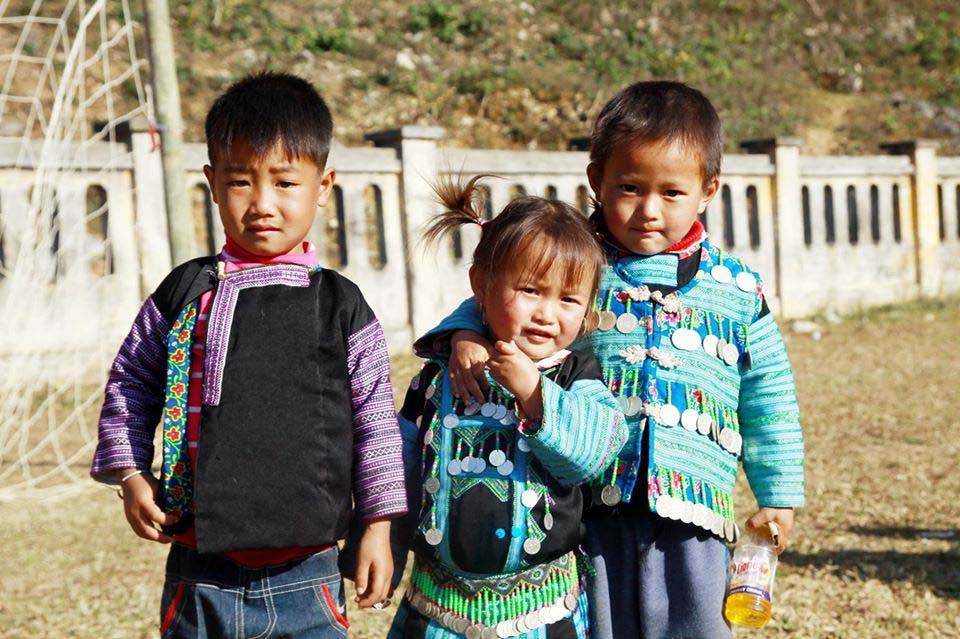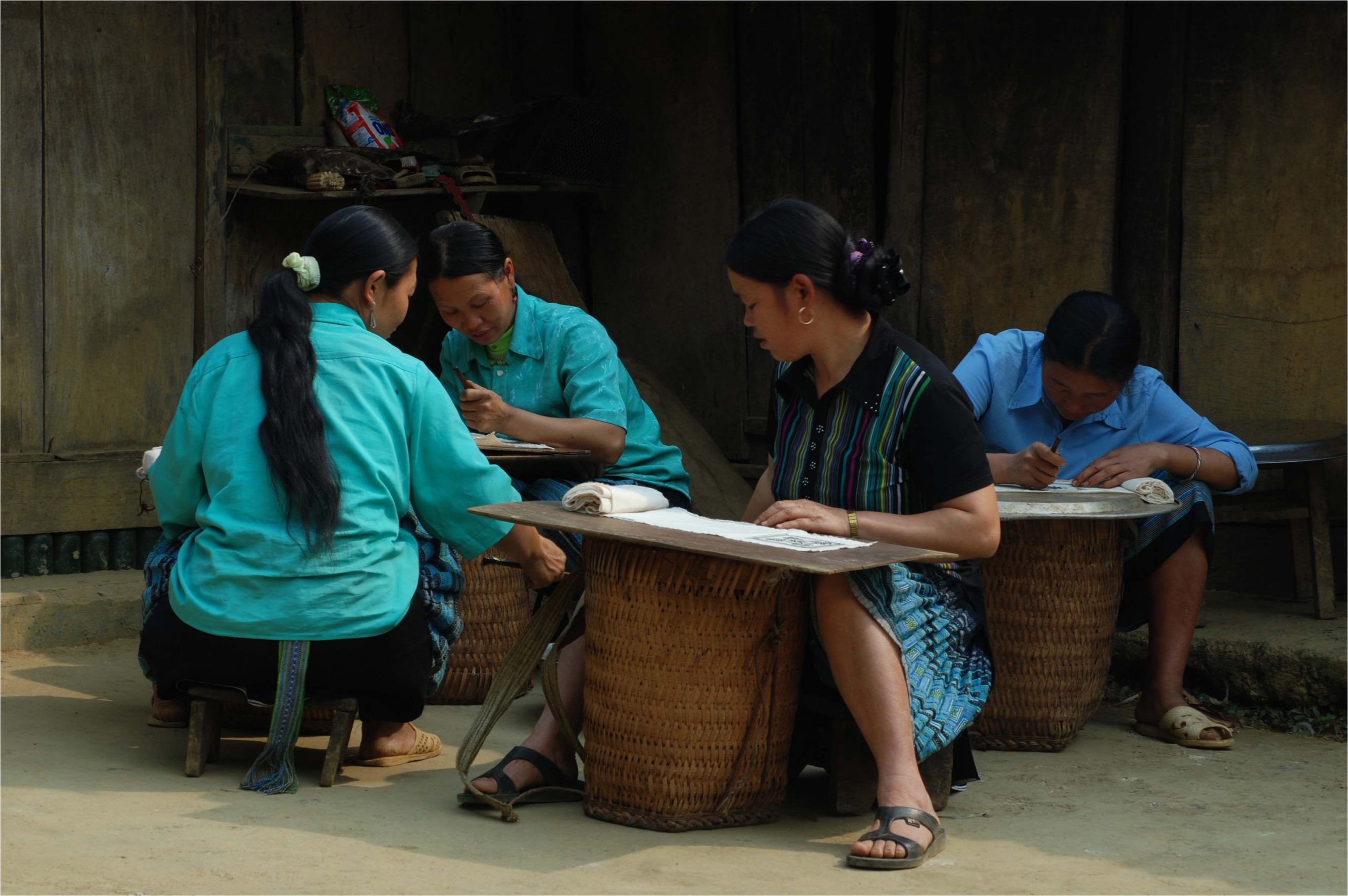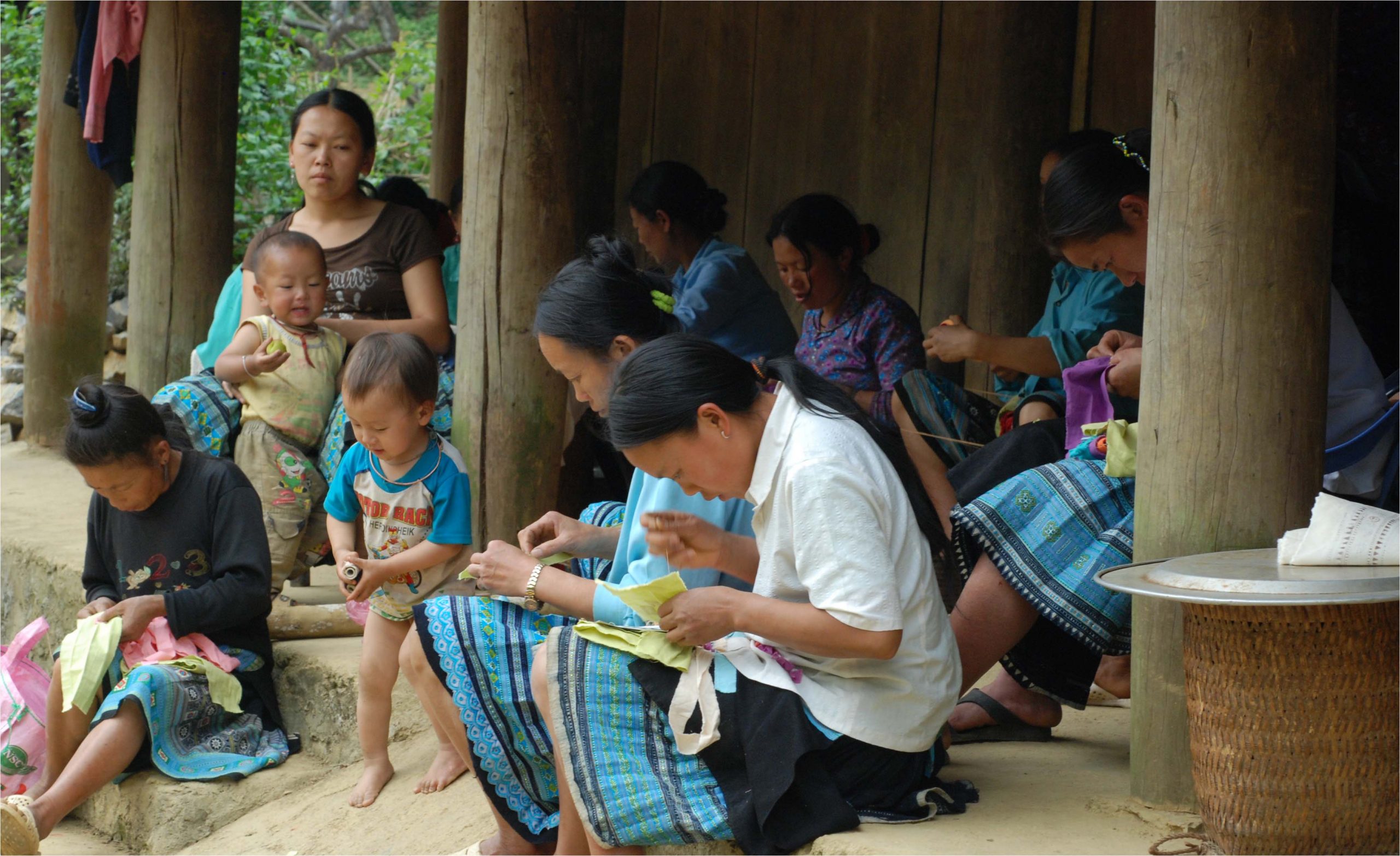No longer permitted to grow opium, the Hmong in Mai Chau subsist by cultivating fruit trees, growing corn and a tuber used for making noodles and collecting firewood form the surrounding dense forest. Now assisted by several projects of Oxfam Quebec and Craft Link, Hmong women have the opportunity to use their traditional handicraft skills to earn additional income.
Hmong Culture and Craft
The Hmong of Pa Co are sometimes labeled “Blue Hmong” because women wear an indigo-dyed head cloth for special occasions and they use fabric in shades of blue to decorate the batiked indigo cloth of their full knee-length skirts.
Pa Co commune is nestled in high hills and deep valleys often blanked by dense fog. Houses traditional have low thatched roofs and no windows. Interiors are dark and filled with smoke from an open fire. Sheets of paper cut with intricate patterns are attached to the interior of house walls in worship of the ancestors. The Hmong make the paper with bamboo pulp, which is dried on a cloth made of old skirts that is stretched on a wooden frame. A Mo, the village ceremonial maser, often performs rituals for the ancestors and to placate bad spirits.
Through the fog of Pa Co one sees women wearing their beautiful skirts and carrying loads of firewood and corn in a basket called a kia. Often they are embroidering as they walk, using what moments their hands are free to create decorations for clothing. In the fog one can also see skirts draped to dry on woodpiles or laundry poles, or on the rough wood plank fences, which surround Hmong houses. The draped half-wheels of the skirts form part of the landscape of a Hmong environment, and in observing the attention paid to the making and care of the skirts one can surmise that it is something which significantly expresses their unique presence in the world.
The making of a skirt is a process, which is part of nearly each day of a woman’s life. Hemp is collected in the spring and dried. The fiber is then split into narrower pieces, a process which may be done in moments of free time: woman walk to and from the field splitting fibers which are wound around one hand. Next the fiber is spun into thread to be woven over the summer months. Dyeing takes place in August and September, a process, which can take between ten days and one month, depends on the quality of the indigo. Today in Pa Co fewer women are making hemp because of the time involved and because they find hemp too heavy and hot. Hemp cloth is still given, however as a gift at weddings.
For the central portion of the skirt, the Hmong purchase white cotton cloth woven by Thai people. First a woman washes 3 arms-lengths (sai) of cloth and melts 200 grams of beeswax. Next the fabric is stretched on a flat piece of wood. Using a tool called a da trang ta, she makes intricate patterns. The completed waxed cloth is then put in an indigo dye bath once a day for about 25 days. When the dying process is completed, the cloth is submerged in a container of hot water to release the wax. The dried cloth is appliqued and embroidered. (In Pa Co today, young girls spend less time making intricate batik design, replacing batik motifs with appliqued colorful market cloth.)
When 3 sai of cloth are fully decorated, the skirt can be assembled.
The batik design and the construction of the skirt are different in the Hmong commune of Hang Kia, which is a few kilometers away.
While the Hmong skirt distinctly expresses the identity of a Hmong community more than any other article of clothing, it is subject to regular changes in fashion. Even so, this year’s skirt, which all young girls will reproduce, using the same patterns of appliqued cloth, will perpetuate a single community identity.
Mothers pay special attention to the making of a batiked, embroidered and appliqued rectangle of cloth used for carrying the babies. A woman is most busy sewing for her family just before the Tet celebration. She makes embroidered aprons and shirt with decorative sleeves and collars. In one year she will make 1-2 sets of clothes per family member. Young girls help by making cross-stitch embroidery for sleeves, or by sewing patches of cloth to skirts. During the years of courtship (usually age 15-18) a girl is most interested in skirt making. She and her friends will wear their best skirts, shirts and aprons on the occasion of Tet and for marriage parties. During Tet, boys and girls each form a line to play a ball game called Lo po po. As they throw the ball and make jokes, they have the chance to observe each other. Later they may meet and sing songs they make up to fit a set melody, or play tunes on a banana leaf. The boy may also visit the girl’s home at night, knocking on the wall by which she sleeps and entreating her to meet him.
Marriages often take place by abduction. After the girl is brought to the boy’s house, his family makes an agreement with her parents, which typically involves the provision of a pig and wine for the wedding party. The new and wine for the wedding party. The new couple will stay with the boy’s family until they can afford a separate household.












For more information about this project, please contact:
CRAFT LINK
Ad: 51 Van Mieu Str., Hanoi, Vietnam
Tel: (8424) 3733 6101
Email: craftlink@fpt.vn
Web: www.craftlink.com.vn
FB: facebook.com/craftlink.com.vn
IG: instagram.com/craftlinkvietnam





